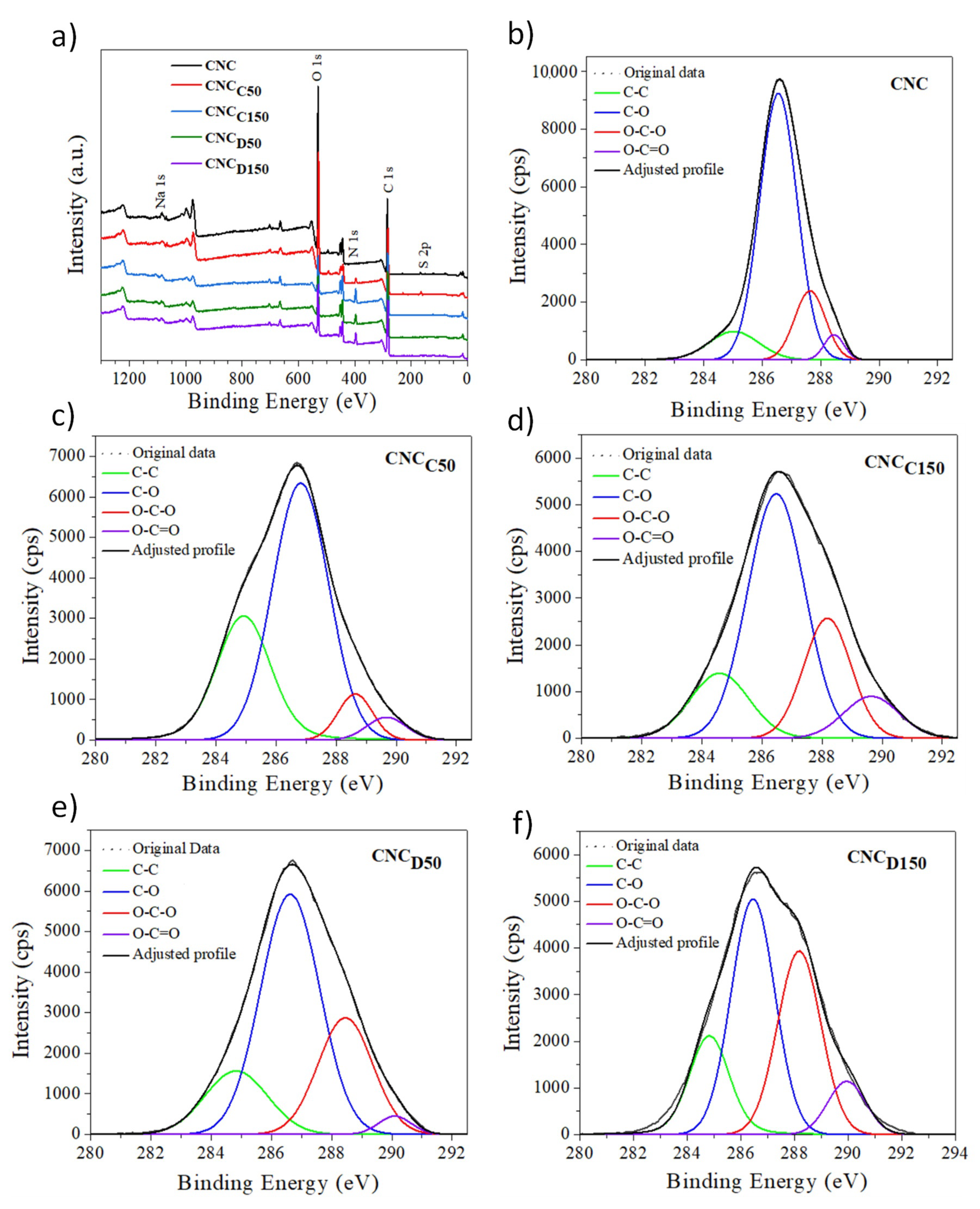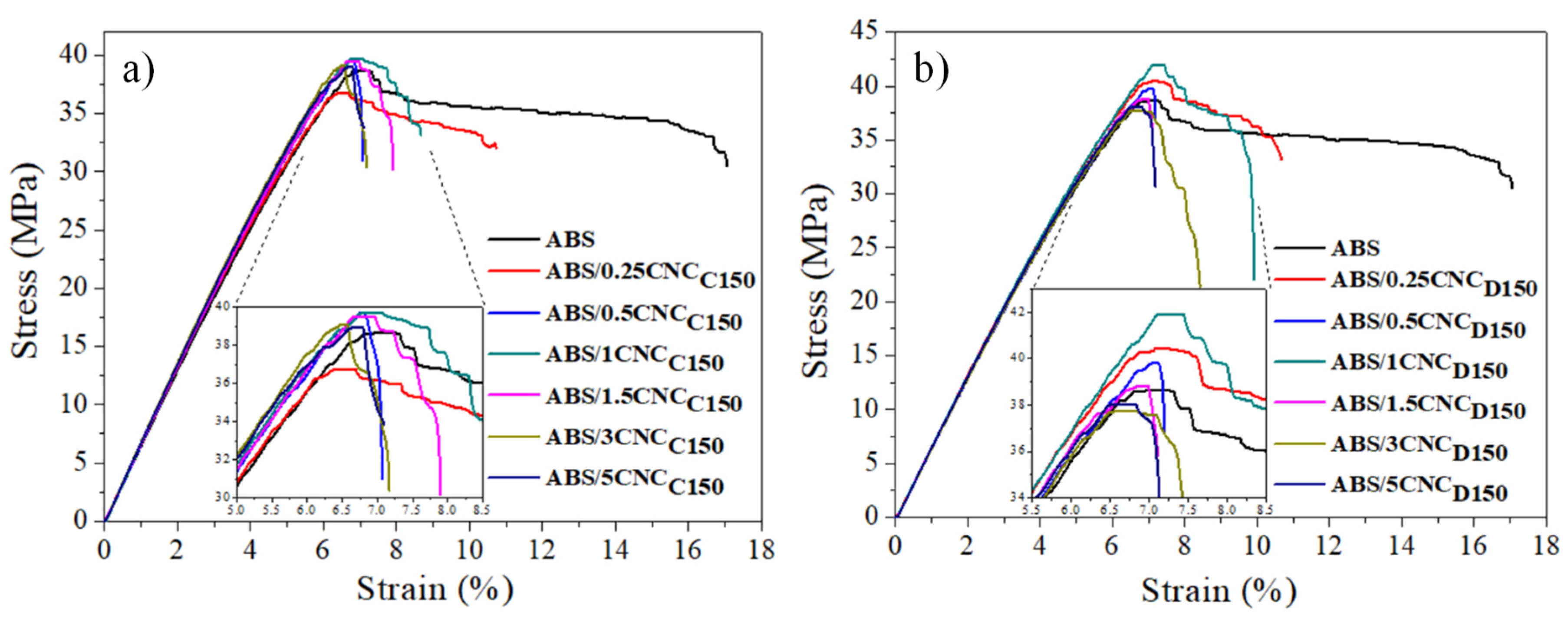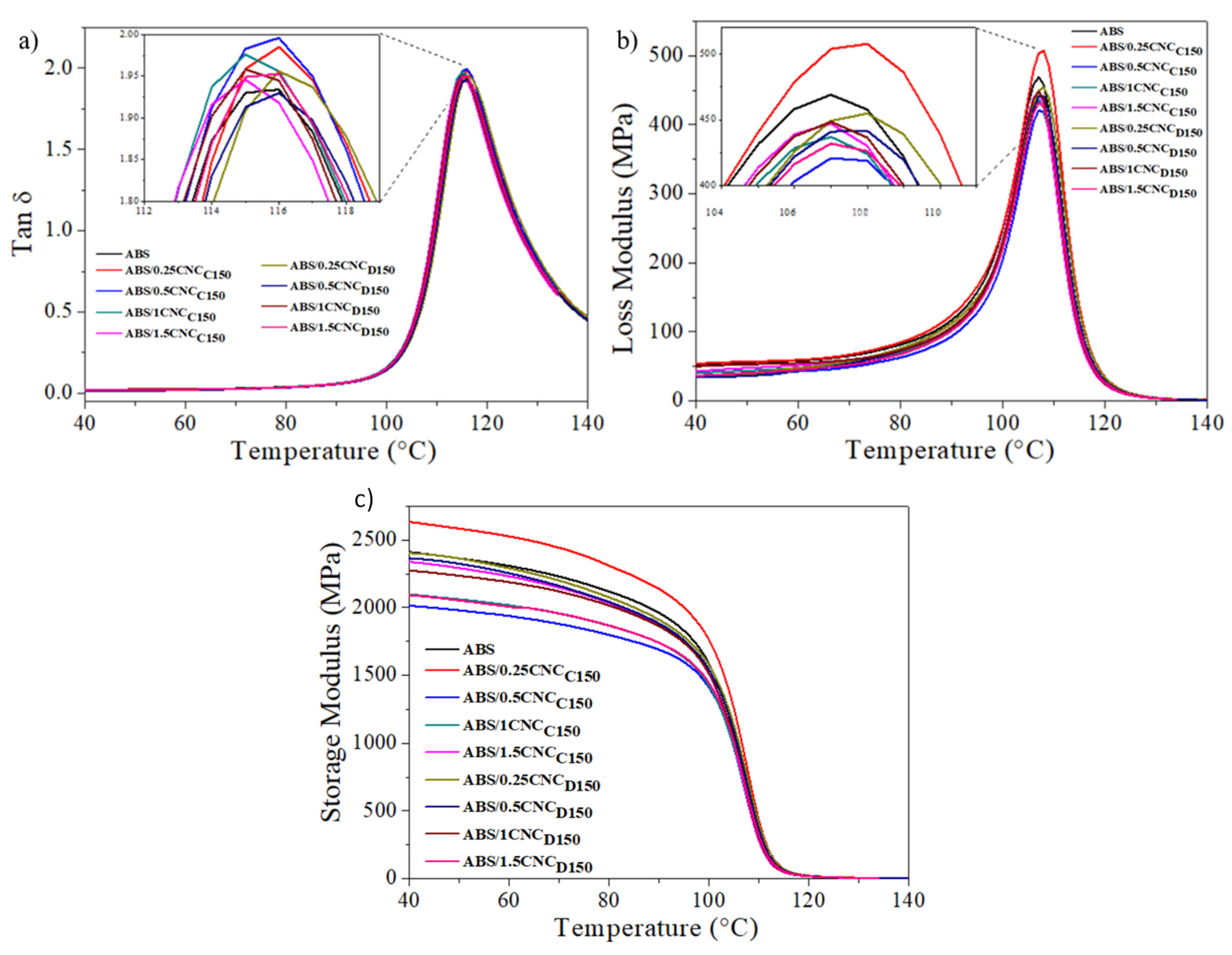Surface Modification of Cellulose Nanocrystals with Lactone Monomers via Plasma-Induced Polymerization and Their Application in ABS Nanocomposites
Abstract
1. Introduction
2. Materials and Methods
2.1. Materials
2.2. Plasma-Induced Polymerization
2.3. ABS Nanocomposites
2.4. Characterization of Surface-Modified Cellulose Nanocrystals
2.5. Characterization of ABS Nanocomposites
3. Results and Discussion
3.1. Surface Modification of CNC
3.2. ABS Nanocomposites
4. Conclusions
Author Contributions
Funding
Institutional Review Board Statement
Informed Consent Statement
Acknowledgments
Conflicts of Interest
References
- Kobayashi, S.; Gan, J.; Osada, T.; Sakaguchi, M. Effect of compatibilizing agent on the fiber-matrix adhesion and mechanical properties of lignocellulose fiber reinforced polyolefin. Adv. Compos. Mater. 2020, 29, 377–387. [Google Scholar] [CrossRef]
- Valencia, L.; Kumar, S.; Nomena, E.M.; Salazar-Alvarez, G.; Mathew, A.P. In-Situ Growth of Metal Oxide Nanoparticles on Cellulose Nanofibrils for Dye Removal and Antimicrobial Applications. ACS Appl. Nano Mater. 2020, 3, 7172–7181. [Google Scholar] [CrossRef]
- Valencia, L.; Rosas, W.; Aguilar-Sanchez, A.; Mathew, A.P.; Palmqvist, A.E.C. Bio-based Micro-/Meso-/Macroporous Hybrid Foams with Ultrahigh Zeolite Loadings for Selective Capture of Carbon Dioxide. ACS Appl. Mater. Interfaces 2019, 11, 40424–40431. [Google Scholar] [CrossRef]
- Valencia, L.; Nomena, E.M.; Mathew, A.P.; Velikov, K.P. Biobased Cellulose Nanofibril–Oil Composite Films for Active Edible Barriers. ACS Appl. Mater. Interfaces 2019, 11, 16040–16047. [Google Scholar] [CrossRef] [PubMed]
- Valencia, L.; Kumar, S.; Jalvo, B.; Mautner, A.; Salazar-Alvarez, G.; Mathew, A.P. Fully bio-based zwitterionic membranes with superior antifouling and antibacterial properties prepared via surface-initiated free-radical polymerization of poly(cysteine methacrylate). J. Mater. Chem. A 2018, 6, 16361–16370. [Google Scholar] [CrossRef]
- Rånby, B.G.; Banderet, A.; Sillén, L.G. Aqueous Colloidal Solutions of Cellulose Micelles. Acta Chem. Scand. 1949, 3, 649–650. [Google Scholar] [CrossRef]
- Habibi, Y.; Lucia, L.A.; Rojas, O.J. Cellulose nanocrystals: Chemistry, self-assembly, and applications. Chem. Rev. 2010, 110, 3479–3500. [Google Scholar] [CrossRef] [PubMed]
- Trache, D.; Hussin, M.H.; Haafiz, M.K.M.; Thakur, V.K. Recent progress in cellulose nanocrystals: Sources and production. Nanoscale 2017, 9, 1763–1786. [Google Scholar] [CrossRef]
- Eyley, S.; Thielemans, W. Surface modification of cellulose nanocrystals. Nanoscale 2014, 6, 7764–7779. [Google Scholar] [CrossRef] [PubMed]
- Carlmark, A. Tailoring Cellulose Surfaces by Controlled Polymerization Methods. Macromol. Chem. Phys. 2013, 214, 1539–1544. [Google Scholar] [CrossRef]
- Tizzotti, M.; Charlot, A.; Fleury, E.; Stenzel, M.; Bernard, J. Modification of Polysaccharides Through Controlled/Living Radical Polymerization Grafting-Towards the Generation of High Performance Hybrids. Macromol. Rapid Commun. 2010, 31, 1751–1772. [Google Scholar] [CrossRef]
- Georgouvelas, D.; Jalvo, B.; Valencia, L.; Papawassiliou, W.; Pell, A.J.; Edlund, U.; Mathew, A.P. Residual Lignin and Zwitterionic Polymer Grafts on Cellulose Nanocrystals for Antifouling and Antibacterial Applications. ACS Appl. Polym. Mater. 2020, 2, 3060–3071. [Google Scholar] [CrossRef]
- Yasuda, H.; Yasuda, T. The competitive ablation and polymerization (CAP) principle and the plasma sensitivity of elements in plasma polymerization and treatment. J. Polym. Sci. Part A Polym. Chem. 2000, 38, 943–953. [Google Scholar] [CrossRef]
- Yasuda, H. Glow discharge polymerization. J. Polym. Sci. Macromol. Rev. 1981, 16, 199–293. [Google Scholar] [CrossRef]
- Baeyer, A.; Villiger, V. Einwirkung des Caro’schen Reagens auf Ketone. Ber. Der Dtsch. Chem. Ges. 1899, 32, 3625–3633. [Google Scholar] [CrossRef]
- Ravotti, R.; Fellmann, O.; Lardon, N.; Fischer, L.J.; Stamatiou, A.; Worlitschek, J. Investigation of Lactones as Innovative Bio-Sourced Phase Change Materials for Latent Heat Storage. Molecules 2019, 24, 1300. [Google Scholar] [CrossRef]
- Choi, E.-J.; Park, J.-K. Study on biodegradability of PCL/SAN blend using composting method. Polym. Degrad. Stab. 1996, 52, 321–326. [Google Scholar] [CrossRef]
- McKeen, L.W. Styrenic Plastics. In Fatigue and Tribological Properties of Plastics and Elastomers; Elsevier: Amsterdam, The Netherlands, 2010; pp. 51–71. [Google Scholar] [CrossRef]
- Kulich, D.M.; Gaggar, S.K.; Lowry, V.; Stepien, R. Acrylonitrile-Butadiene-Styrene (ABS) Polymers. In Kirk-Othmer Encyclopedia of Chemical Technology; John Wiley & Sons, Inc.: Hoboken, NJ, USA, 2003. [Google Scholar] [CrossRef]
- Ramos-de Valle, L.F.; Neira-Velazquez, M.G.; Hernández-Hernández, E. Surface modification of CNFs via plasma polymerization of styrene monomer and its effect on the properties of PS/CNF nanocomposites. J. Appl. Polym. Sci. 2008, 107, 1893–1899. [Google Scholar] [CrossRef]
- Alanis, A.; Valdés, J.H.; Guadalupe, N.-V.M.; Lopez, R.; Mendoza, R.; Mathew, A.P.; de León, R.D.; Valencia, L. Plasma surface-modification of cellulose nanocrystals: A green alternative towards mechanical reinforcement of ABS. RSC Adv. 2019, 9, 17417–17424. [Google Scholar] [CrossRef]
- Park, S.; Baker, J.O.; Himmel, M.E.; Parilla, P.A.; Johnson, D.K. Cellulose crystallinity index: Measurement techniques and their impact on interpreting cellulase performance. Biotechnol. Biofuels 2010, 3, 10. [Google Scholar] [CrossRef]
- Segal, L.; Creely, J.J.; Martin, A.E.; Conrad, C.M. An Empirical Method for Estimating the Degree of Crystallinity of Native Cellulose Using the X-Ray Diffractometer. Text. Res. J. 1959, 29, 786–794. [Google Scholar] [CrossRef]
- Ciolacu, D.; Ciolacu, F.; Popa, V.I. Amorphous Cellulose-Structure and Characterization. Cellul. Chem. Technol. 2011, 45, 13. [Google Scholar]
- Vanderfleet, O.M.; Reid, M.S.; Bras, J.; Heux, L.; Godoy-Vargas, J.; Panga, M.K.R.; Cranston, E.D. Insight into thermal stability of cellulose nanocrystals from new hydrolysis methods with acid blends. Cellulose 2019, 26, 507–528. [Google Scholar] [CrossRef]
- Bradbury, A.G.W.; Sakai, Y.; Shafizadeh, F. A kinetic model for pyrolysis of cellulose. J. Appl. Polym. Sci. 1979, 23, 3271–3280. [Google Scholar] [CrossRef]
- Lin, Y.-C.; Cho, J.; Tompsett, G.A.; Westmoreland, P.R.; Huber, G.W. Kinetics and Mechanism of Cellulose Pyrolysis. J. Phys. Chem. C 2009, 113, 20097–20107. [Google Scholar] [CrossRef]
- Soares, S.; Camino, G.; Levchik, S. Comparative study of the thermal decomposition of pure cellulose and pulp paper. Polym. Degrad. Stab. 1995, 49, 275–283. [Google Scholar] [CrossRef]
- Chen, L.; Wang, Q.; Hirth, K.; Baez, C.; Agarwal, U.P.; Zhu, J.Y. Tailoring the yield and characteristics of wood cellulose nanocrystals (CNC) using concentrated acid hydrolysis. Cellulose 2015, 22, 1753–1762. [Google Scholar] [CrossRef]
- Johansson, L.-S.; Campbell, J.M. Reproducible XPS on biopolymers: Cellulose studies. Surf. Interface Anal. 2004, 36, 1018–1022. [Google Scholar] [CrossRef]
- Eyley, S.; Schütz, C.; Thielemans, W. Surface Chemistry and Characterization of Cellulose Nanocrystals. In Cellulose Science and Technology; John Wiley & Sons, Inc.: Hoboken, NJ, USA, 2018; pp. 223–252. [Google Scholar] [CrossRef]
- Valencia, L.; Arumughan, V.; Jalvo, B.; Maria, H.J.; Thomas, S.; Mathew, A.P. Nanolignocellulose Extracted from Environmentally Undesired Prosopis juliflora. ACS Omega 2019, 4, 4330–4338. [Google Scholar] [CrossRef]
- Enríquez-Medrano, F.J.; Soriano-Corral, F.; Acuña-Vázquez, P.; Cabrera-Álvarez, E.N.; Saade-Caballero, H.; Castañeda-Facio, A.; Valencia-López, L.; Díaz-de-León, R. Synthesis and Characterization of NBR’s by RAFT Technique and their use as Rubber Precursor in ABS Type Resins. J. Mex. Chem. Soc. 2014, 58, 195–201. [Google Scholar] [CrossRef]
- Huang, G.; Huo, S.; Xu, X.; Chen, W.; Jin, Y.; Li, R.; Song, P.; Wang, H. Realizing simultaneous improvements in mechanical strength, flame retardancy and smoke suppression of ABS nanocomposites from multifunctional graphene. Compos. Part B Eng. 2019, 177, 107377. [Google Scholar] [CrossRef]
- Simonsen, J.; Habibi, Y. Cellulose Nanocrystals in Polymer Matrices. In The Nanoscience and Technology of Renewable Biomaterials; John Wiley & Sons, Ltd.: Hoboken, NJ, USA, 2009; pp. 273–292. [Google Scholar] [CrossRef]
- Leão, R.M.; Jesus, L.C.C.; Bertuoli, P.T.; Zattera, A.J.; Maia, J.M.L.L.; del Menezzi, C.H.S.; Amico, S.C.; da Luz, S.M. Production and characterization of cellulose nanocrystals/acrylonitrile butadiene styrene nanocomposites. J. Compos. Mater. 2020, 54, 4207–4214. [Google Scholar] [CrossRef]
- Iwamoto, S.; Kai, W.; Isogai, A.; Iwata, T. Elastic Modulus of Single Cellulose Microfibrils from Tunicate Measured by Atomic Force Microscopy. Biomacromolecules 2009, 10, 2571–2576. [Google Scholar] [CrossRef] [PubMed]
- Wei, X.; Li, D.; Jiang, W.; Gu, Z.; Wang, X.; Zhang, Z.; Sun, Z. 3D Printable Graphene Composite. Sci. Rep. 2015, 5, 11181. [Google Scholar] [CrossRef] [PubMed]
- Ünal, H.Y.; Öner, G.; Pekbey, Y. Comparison of the Experimental Mechanical Properties and DMA Measurement of Nanoclay Hybrid Composites. Eur. Mech. Sci. 2017, 2, 31–36. [Google Scholar] [CrossRef]










| m-CNC | Monomer | Plasma Power (W) |
|---|---|---|
| CNCC50 | ε-caprolactone | 50 |
| CNCC100 | ε-caprolactone | 100 |
| CNCC150 | ε-caprolactone | 150 |
| CNCD50 | δ-decalactone | 50 |
| CNCD100 | δ-decalactone | 100 |
| CNCD150 | δ-decalactone | 150 |
| Sample | Filler | Concentration (wt%) |
|---|---|---|
| ABS | − | − |
| ABS/0.25CNCC150 | CNCC150 | 0.25 |
| ABS/0.5CNCC150 | CNCC150 | 0.5 |
| ABS/1CNCC150 | CNCC150 | 1.0 |
| ABS/1.5CNCC150 | CNCC150 | 1.5 |
| ABS/3CNCC150 | CNCC150 | 3.0 |
| ABS/5CNCC150 | CNCC150 | 5.0 |
| ABS/0.25CNCD150 | CNCD150 | 0.25 |
| ABS/0.5CNCD150 | CNCD150 | 0.5 |
| ABS/1CNCD150 | CNCD150 | 1.0 |
| ABS/1.5CNCD150 | CNCD150 | 1.5 |
| ABS/3CNCD150 | CNCD150 | 3.0 |
| ABS/5CNCD150 | CNCD150 | 5.0 |
| Sample | Ia (200), Cps | Iab, Cps | (%) | τ c, Nm (200) |
|---|---|---|---|---|
| CNC | 14,949 | 1866 | 88 | 4.1 |
| CNCC50 | 15,034 | 2038 | 86 | 4.1 |
| CNCC100 | 15,178 | 2252 | 85 | 4.0 |
| CNCC150 | 14,321 | 1908 | 87 | 4.1 |
| CNCD50 | 15,428 | 1998 | 87 | 4.1 |
| CNCD100 | 15,065 | 1733 | 87 | 4.1 |
| CNCD150 | 15,072 | 2371 | 84 | 3.9 |
| Sample | Binding Energy (eV) | ||||
|---|---|---|---|---|---|
| C/O | 285 (C–C) | 287 (C–O) | 288 (O–C–O) | 289 (O–C=O) | |
| CNC | 1.39 | 10.14% | 71.18% | 15.14% | 3.54% |
| CNCC50 | 1.89 | 29.91% | 59.80% | 6.56% | 3.72% |
| CNCC150 | 5.20 | 14.91% | 54.18% | 21.99% | 8.91% |
| CNCD50 | 5.33 | 15.85% | 56.50% | 25.28% | 2.37% |
| CNCD150 | 3.67 | 17.41% | 41.92% | 32.42% | 8.25% |
| Sample | Tg (°C) Loss Modulus | Tg (°C) Tan δ |
|---|---|---|
| ABS | 107.1 | 115.5 |
| ABS/0.25CNCC150 | 107.6 | 116.0 |
| ABS/0.5CNCC150 | 107.5 | 115.6 |
| ABS/1CNCC150 | 106.9 | 115.0 |
| ABS/1.5CNCC150 | 105.0 | 113.0 |
| ABS/0.25CNCD150 | 107.8 | 116.0 |
| ABS/0.5CNCD150 | 107.5 | 116.0 |
| ABS/1CNCD150 | 107.0 | 115.5 |
| ABS/1.5CNCD150 | 107.3 | 115.5 |
Publisher’s Note: MDPI stays neutral with regard to jurisdictional claims in published maps and institutional affiliations. |
© 2021 by the authors. Licensee MDPI, Basel, Switzerland. This article is an open access article distributed under the terms and conditions of the Creative Commons Attribution (CC BY) license (https://creativecommons.org/licenses/by/4.0/).
Share and Cite
Díaz de León, R.; Guzmán, E.; López González, R.; Díaz Elizondo, A.; Magaña, I.; Neira, G.; Castañeda Facio, A.; Valencia, L. Surface Modification of Cellulose Nanocrystals with Lactone Monomers via Plasma-Induced Polymerization and Their Application in ABS Nanocomposites. Polymers 2021, 13, 2699. https://doi.org/10.3390/polym13162699
Díaz de León R, Guzmán E, López González R, Díaz Elizondo A, Magaña I, Neira G, Castañeda Facio A, Valencia L. Surface Modification of Cellulose Nanocrystals with Lactone Monomers via Plasma-Induced Polymerization and Their Application in ABS Nanocomposites. Polymers. 2021; 13(16):2699. https://doi.org/10.3390/polym13162699
Chicago/Turabian StyleDíaz de León, Ramón, Ediberto Guzmán, Ricardo López González, Alejandro Díaz Elizondo, Ilse Magaña, Guadalupe Neira, Adali Castañeda Facio, and Luis Valencia. 2021. "Surface Modification of Cellulose Nanocrystals with Lactone Monomers via Plasma-Induced Polymerization and Their Application in ABS Nanocomposites" Polymers 13, no. 16: 2699. https://doi.org/10.3390/polym13162699
APA StyleDíaz de León, R., Guzmán, E., López González, R., Díaz Elizondo, A., Magaña, I., Neira, G., Castañeda Facio, A., & Valencia, L. (2021). Surface Modification of Cellulose Nanocrystals with Lactone Monomers via Plasma-Induced Polymerization and Their Application in ABS Nanocomposites. Polymers, 13(16), 2699. https://doi.org/10.3390/polym13162699








